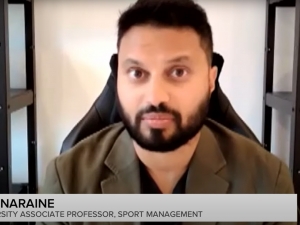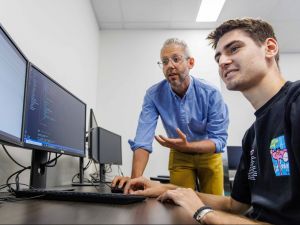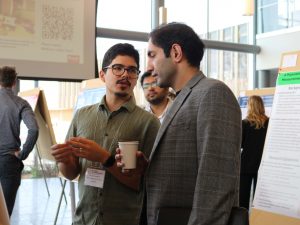 Organizer Harris Sheikh welcomes the crowd to Brock’s Undergraduate Research Conference on March 16.
Organizer Harris Sheikh welcomes the crowd to Brock’s Undergraduate Research Conference on March 16.The inner workings of DNA, skin blood flow and antibiotic-resistant bacteria were among the research topics that took centre stage during the recent Undergraduate Research Conference.
The March 16 competition, organized by the Brock University Math and Science Council (BUMSC), saw a panel of judges evaluate presentations from seven undergraduate students.
Jina Nanayakkara, a third-year student in the Department of Biological Sciences, captured the Best Presentation award for her exploration of jumping genes — a sequence of DNA that can copy and insert itself into another location.
Jumping genes can be related to gene expression, a process in which information from a gene is used to make proteins and other products in cells all over the body. When genes are activated in specific cells mutations can sometimes occur.
“This whole process might be relevant to what drives cancer and could openly lead to some clinical applications,” Nanayakkara said.
The competition’s People’s Choice Award went to Bill Truong, a third-year student in the Department of Physics, for his research on superconductors — material that can transport electrons from one atom to another with no resistance at very low temperatures.
Superconductors are used in such things as magnetic-resonance-imaging (MRI) equipment, ultra-high-speed computer chips and high capacity digital memory chips.
“We wanted to take a look at the energy of electrons in a topological superconductor; specifically, we wanted to find the points where the energy was zero,” Truong said.
Judging the five-minute presentations were graduate students Meera Mahmud and Rachel Mervin from the Faculty of Applied Health Sciences and Karin Perry, Graduate Co-ordinator, Development and Training in the Faculty of Graduate Studies.
“Seeing these students getting involved in these big projects, in these big lab studies and being major contributors who are able to present their own data at such an early stage in their career is amazing,” Mervin said.
“They were able to demonstrate their research in a way that matters in real-life scenarios; I’m convinced that some of this research is going to change our world.”
The other contestants included:
- Abiye Mussie (third year, Department of Health Sciences) with research combining biology and chemistry to synthesize an unnatural analogue of a compound shown to inhibit or prevent the development of malignant cells that could otherwise lead to cancer. This analogue must be synthesized so that it may be soluble in a water-based medium, and thus readily distributed throughout the body.
- Matthew Mueller (fourth year, Department of Kinesiology) studying differences in skin blood flow in children and adults. Skin blood flow changes in response to temperature and exercise, but these changes have not been well characterized in children. Blood carries heat, so the greater the amount of skin blood flow, the greater the amount of heat that is lost to the environment through the skin.
- Wryan Helmeczi (third year, Department of Health Sciences) researches the establishment of a practical and safe method that independent parties may use to determine gold abundance in a variety of sources, including geological sites. Methods being explored may help to overcome barriers accurate detection and gold digestion — the chemical process that separates gold from the surrounding material in which it is found.
- Rhys Powers (fourth year, Department of Biotechnology) studies “Z DNA,” a form of DNA that has a different structure from the more common “B DNA.” Through the process of DNA transcription, it may be possible that this other form of DNA may be linked to certain diseases.
- Frank Betancourt (fourth year, Department of Biotechnology) researches biofilm, a layer of bacteria that forms over specific objects. Biofilm can be an issue in areas such as operating rooms where catheters and other items are going into the body with the antibiotic-resistant bacteria layer on them. Betancourt is looking at how bacteria communicate with via acyl-homoserine-lactones to form biofilms with the future goal of stopping these molecules from being produced, which would stop the production of biofilm.

Seven undergraduate students, including Matthew Mueller, Bill Truong, Jina Nanayakkar, Abiye Mussie, Frank Betancourt, Rhys Powers and Wryan Helmeczi, presented their research during the Undergraduate Research Conference on March 16.








